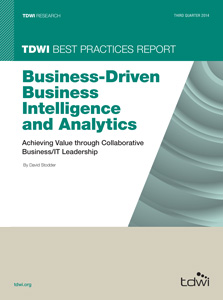
Best Practices Report | Business-Driven BI and Analytics
June 25, 2014
One of the chief goals of nearly all organizations today is to enable data-driven decisions and
actions. Firms want to achieve the “right data, for the right user, at the right time” objective that has
characterized business intelligence (BI) and data warehousing since their beginnings. They also want
to enable users to push beyond canned reports and limited spreadsheet views to take advantage of
more advanced data visualization and analytics; then, users can accelerate exploration and discovery
of valuable insights and apply them for business advantage.
Only in recent years have BI tools, as well as those in the newer categories of data discovery and
software as a service (SaaS), become easy enough for business users to deploy and implement without
considerable handholding by IT developers and data analysts. Analytic database platforms that are
specifically designed to support data discovery and advanced analytics are also now easier to deploy,
load with data, and use. Offering flexible data visualization, dashboard-based information views,
analytics, and more, the latest BI tools, analytic platforms, and SaaS offerings are spurring users in
business functions and lines of business (LOB) to venture beyond the boundaries of IT management
and obtain technologies themselves.
This trend toward “business-driven,” rather than IT-driven BI and analytics, is riding the momentum
created by technology change and strong interest, if not CEO-driven mandates, to infuse data
into all decisions and actions. This TDWI Best Practices Report explores key drivers behind this
trend and examines how organizations are both taking advantage of it and realigning business-IT
collaboration to avoid pitfalls. Organizations need this collaboration to allocate resources effectively
and adhere to data governance policies.
Our research finds that, overall, IT still plays a major, if not dominant, role in BI and analytics
implementations. As they have historically, IT and corporate-level leadership still head up
sponsorship of most BI and analytics projects. However, it is becoming more important to avoid
“technology for technology’s sake” and to define the benefits of technology deployment in terms
of business advantages, such as smarter financial management, more effective marketing, or more
efficient operational processes. Business-side leadership and IT leadership need to align business and
technology objectives so that projects can succeed in satisfying users.
One way that some organizations have effectively brought together business and IT leadership is by
establishing a BI and analytics center of excellence (CoE) or competency center. Such an institution
can bring the sides together to share best practices, identify training needs, tighten alignment
between BI and analytics and business processes, manage data governance, and more. Currently,
however, our research finds that business-side participation in CoEs and competency centers is low.
If business-driven BI and analytics are to be sustained with less direct IT involvement, business-side
leadership must step up to ensure that chaos does not reign and to provide direction for the adoption
of new technologies and practices for the betterment of the enterprise as a whole. Otherwise,
organizations could invite data confusion and unnecessarily waste precious budget and resources.